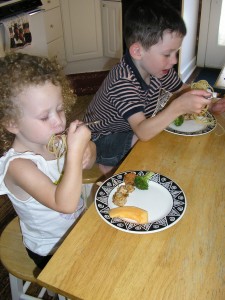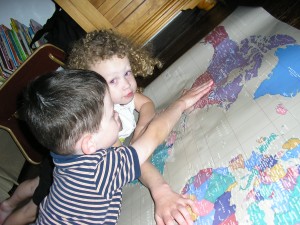 My kids are eight years old and five years old, and for the most part, I like to stay out of the their arguments. Personally, I think there is greater skill to be gained by learning to work out disagreements and learn to cooperate than by me stepping in to solve everything.
My kids are eight years old and five years old, and for the most part, I like to stay out of the their arguments. Personally, I think there is greater skill to be gained by learning to work out disagreements and learn to cooperate than by me stepping in to solve everything.
That being said, I don’t just leave the kids out to the wolves; my goal has been to give them the tools they need to solve disagreements on their own in a way that’s fair to both of them. (The fantastic book Siblings Without Rivalry was a great help to me in negotiating the potential trials of parenting siblings!)
I’ll make observations, (“Wow, this is a big problem! Brother wants to use the red marker, and Sister wants to use it too!”) I’ll listen to both sides of the story, (“Okay, I’ll listen to Sister first, and then when she’s done telling me all she wants to say about it, I’ll listen to Brother.”) and then I’ll leave them to it. (“This is a big problem, but I’m confident the two of you can work it out in a way that’s fair to both of you.”)
To be honest, saying the bit about “…that’s fair to both of you” seems to be a reminder to my kids that they need to cooperate.
There are a few rules I follow:
1.) If one person personally owns something that the other person wants to use, the owner always gets the final answer. (“Sister, so you want to listen to one of your brother’s cd’s, but you, Brother, says she can’t use it. It’s your choice, Brother, because it’s yours, and if you both want to work something out, it’s between the two of you.” In this case, it seems as long as I acknowledge and support the ownership of the item, then the owner is much more willing to share. I never demand the kids share personally owned items.)
2.) Physically hurting each other is not allowed, and I would immediately step in and separate them. Fortunately, my kids never really had a problem with this, so it never really comes up. In fact, the last time I had to deal with this was several years ago.
3.) If a problem is so big that they need help, I help them brainstorm different ideas. But I do not make the final choice. This I think, teaches them more than anything else, how to solve their own problems. Brainstorming involves asking both of them for ideas to solve the problem, and I write down every single idea that’s spoken. Silly or ridiculous or feasible. Then it’s up to the kids to choose the best idea and to implement it. I’ve done this so often over the years that the kids brainstorm all by themselves now, and come up with their own solutions.
An example of this is bathtime. The kids still bathe together. (Neither one has asked for their own bath, which would immediately be honored.) However, both kids like to sit up front where the water’s deeper and warmer! It got to be too much of a hassle at bathtime determining which one got to sit up front, so I told the kids that we need a better way to make the determination.
The kids talked about it, and came up with a surprisingly fair solution. If I could print out a monthly calendar, Brother would fill in each day with alternating the first initial of their names to indicate which person got to sit up front during bath. Then Sister would mark off each day by putting a sticker on the calendar each evening.
I was impressed. This was a big problem, and they came up with a solution that’s fair to both of them.
They’ve been doing this for about four months, and it’s worked perfectly! They both follow the schedule because they both came up with it. All I have to do is print out a calendar at the beginning of each month, and they take care of the rest.
The reason this is on my mind is because they found another use for the calendar a couple of days ago. I just recently set up an account for my daughter on my computer. My son has had one for a few years. The rule is they can use the computer just on weekends. However, with two kids now wanting turns instead of just one, I began to wonder what would happen.
I left the room for about a half hour, and then came back in. My daughter announced they they talked about that very problem and what they could do. They’re going to use the bath calendar, and whoever’s name is on the calendar gets to use the computer first. It works out well since the weekend days on the calendar alternate as well.
They discovered the problem themselves (“How will we decide who gets to use the computer first?”) and they talked it over and came up with a plan! And this was all before I had even voiced anything at all about it!
The kids then told me that it was my five-year-old daughter who came up with the idea of using the bath calendar for computer time as well!
I’m so pleased that they’re solving problems entirely on their own!
What are some other ways to foster cooperation between siblings?
photo credit: Joyseph
 Let me tell you this story of what happened the other day. While we were out, my son disappeared from my sight for about 10 minutes. I tell you, not because it’s entertaining, or to share my experience as a warning that “something like this could happen to you someday“, but because when this happened, I didn’t react the way I thought I would. It seems like my AP skills went out the window, and I’m trying to rationalize that. For a few moments, my child was lost, and I lost myself as a parent.
Let me tell you this story of what happened the other day. While we were out, my son disappeared from my sight for about 10 minutes. I tell you, not because it’s entertaining, or to share my experience as a warning that “something like this could happen to you someday“, but because when this happened, I didn’t react the way I thought I would. It seems like my AP skills went out the window, and I’m trying to rationalize that. For a few moments, my child was lost, and I lost myself as a parent.
 The other day, I made lunch for myself and my two kids. Chicken sandwiches on wheat bread all around, apple sauce for them and a pickle for me. I was putting dirty utensils into the sink when I turned around to see that my 5 year old son had snatched the pickle off my plate, taken a bite, handed it to his sister, who also took a bite and handed it back to him. When he looked up and saw me watching him, he said, “I like it! I like pickles!” He took another bite, then placed what was left back on my plate.
The other day, I made lunch for myself and my two kids. Chicken sandwiches on wheat bread all around, apple sauce for them and a pickle for me. I was putting dirty utensils into the sink when I turned around to see that my 5 year old son had snatched the pickle off my plate, taken a bite, handed it to his sister, who also took a bite and handed it back to him. When he looked up and saw me watching him, he said, “I like it! I like pickles!” He took another bite, then placed what was left back on my plate. Learning something when you’ve been told you need to know it is pretty boring sometimes. Following your child’s lead and letting natural interests develop is a lot more interesting.
Learning something when you’ve been told you need to know it is pretty boring sometimes. Following your child’s lead and letting natural interests develop is a lot more interesting.


